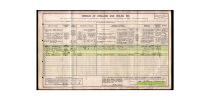The school was funded largely by subscriptions and donations, along with the board and lodging payments for asylum residents, and the income from the children’s labour. In 1858 the school began to take in a large number of children of soldiers killed during the Crimean War, who were paid for by the Patriotic Fund Committee. By 1864, however, income from this source was beginning to decline, and the school began to suffer financial difficulties; this led to the decision of the governors, in 1868, to certify the school under the Industrial Schools Act 1866. This meant that children between the ages of seven and 14 could be placed in the school by magistrates if they were vagrants, if they were under 12 and had committed an offence normally punishable by prison, or were beyond the control of their parents. The maintenance of each child was then paid for by the state, although the school continued to rely on donations and subscriptions for further expenditure. - so most likely Eliza and Matilda were placed by magistrates. Would they have been stealing or begging at their age?
By 1873 there was an increasing view that girls and boys should not be accommodated in the same industrial schools, and this, along with the overcrowded state of the Gem Street premises, prompted the governors to seek separate accommodation for the girls. Accordingly, in December 1873, the girls were removed to a board school at Sparkhill, and from then on the Birmingham Industrial School took only boys. The school by this time was licensed to accommodate 152 children.
So having done a bit more reading the girls were sent to an industrial school for girls which opened in 1873 with children admitted Dec 1873. The site was previously a convalescence hospital. Most of the initial intake came from the girls department at Gem Street which was being closed. Several girls were causing problems apparently that came from Gem Street, and the new school was taking 27 children. Classroom performances were improving but not far advanced. In 1877 the school was closed to make money saving measures and girls were transferred to York, Bath and Liverpool. I know in 1881 Matilda wasnt in birmingham but at Walter Major Lesters home, Kirkdale, Lancashire. So am assuming they transferred Matilda to Liverpool. Re Eliza....she would have been 16 by 1877 so perhaps she was free from the school then?

